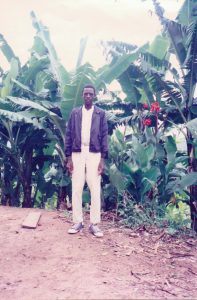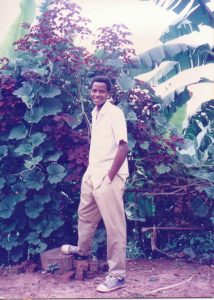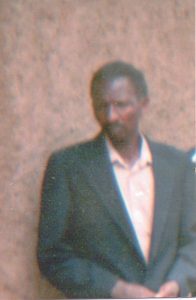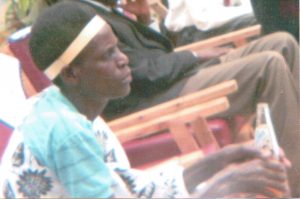
Jean B. Kayigamba
The following testimony was written by Jean Baptiste Kayigamba, a survivor of the Genocide in Rwanda. Please note that the views expressed are those of the author and do not necessarily represent the views of HMDT.
20 years later, the horrors I lived through seem distant. But I continued to have flashbacks and at times I have nightmares about being hunted down by the killers.
My name is Jean Baptiste Kayigamba. I was born in 1963 in the southern province of Rwanda formerly known as Gikongoro (an area considered even today as a hotbed of Hutu extremism). The date of my birth is highly significant as far as the bloody history of post-independence Rwanda is concerned. As a matter of fact, around the time of my birth, wanton killing of Tutsis was already taking place.
I was told by my parents that during that time, Hutu mobs were unleashed by the government to hunt down and kill Tutsis. Once my late mother confided to me that an old Hutu man who was spearheading the killings in my village came looking for my dad, who had gone underground. The man told her that she should not worry because, he said: ‘we are only looking for men and male babies’. The trouble was that she had me on her back and I was a boy. I was told that the killers would snatch the baby boys from their mothers and throw them in the flames of the houses they had just set on fire.
After hiding in the bushes on the hillside for several days, she could not cope with the hunger anymore, and she was desperate to find food for me. She decided to surrender herself to the murderous authorities. Their plan had been to collect the Tutsis and herd them to the nearby Mbirurume River. They were planning to kill and dump us in the river the next morning.
But a miracle happened. As they waited for the dawn to come, and the last Tutsi in our area to come out of hiding, a military jeep turned up at around midnight. The government had decided to halt the massacres all over the country. That was my first narrow escape. I was only three months old!
It had become a pattern under the previous Hutu regimes. The government would tell people to kill; the populace would kill en masse. They would tell them to stop and they would do just that. In 1994, the same happened. They ordered people to exterminate the Tutsis. That’s what they tried to do.
During that period of madness in Gikongoro in the 1960s, according to Rwandan historian Josias Semujanga, an estimated 5,000 were killed in Cyanika and 1,677 were killed in Kaduha parishes respectively, with more than 500 missing. Kaduha was my home parish.
It is said that the killings of Tutsis in Gikongoro spiked on Christmas Day 1963 and continued until 29 December. Most of the victims were taken to the nearby rivers Mwogo and Rukarara. They were murdered by being hit with batons and billhooks.
According to the stories I used to hear, men, women and children, and even babies, were ordered to undress, and then they were thrown into the river. To prevent them from swimming to safety, they were first wounded grievously. In the days that followed, thousands and thousands were seen floating along the Nyabarongo River, a tributary of the River Nile.
But my family had managed to survive and despite all this, they had managed to rebuild their lives. Life in our village was very hard. Our neighbours hated us, because we had a house with a tiled roof, while most peasants in the area were living in grass-thatched ones. In addition, my father was running a small business in the local trade centre. As kids, we could hear people referring to us as Bazungu (White) because they thought we were better off. No wonder that in the years that preceded the Genocide, the children of our Hutu neighbours were telling my siblings that they would kill them and take over our house.
An Apartheid-like system
Growing in post-independence Rwanda was very much like being born in South Africa under the Apartheid regime. Tutsis were discriminated against in all sectors of national life, in education, employment, the military and the police. During the Second Republic, discriminatory practices were officially encoded in national policy under the so-called ‘Quota System’. Because the Tutsis reportedly represented 14 % of the population, only that percentage of Tutsi children was allowed to pursue higher education. Everything was done to keep track of these quotas.
Imagine the shock I had when at the age of five I started primary school. I remember the teacher asking Tutsi and Hutu children to stand up respectively. Some kids were too young to know their ethnic background. It was common that some Tutsi children who were confused and stood up at the wrong time in the wrong group were violently reprimanded, and even caned by the teacher. This practice followed me throughout the seven years of my time at High School, and even later on at the National University of Rwanda.
Another thing that compounded our continual harassment was the fact our classmates often asked to examine our palm signs and would come to the conclusion that we were Tutsis. They would also refer to the fact that our noses were aquiline, and that theirs were flat.
All these were some of the characteristic features found in the early racial publications by the first European anthropologists to set their feet in Africa. According to these myths the Tutsi were aliens, who came from Abyssinia and settled in Rwanda in the 15th century. But the proponents of this myth failed to explain the fact that the Tutsi who are foreigners managed to forget their dialect and now use the Kinyarwanda like the Hutu, who were said to originate from the region around Lake Chad.
What is regrettable is that these myths were turned into key material taught in the history classes of the country. So, we grew feeling different. Our Hutu classmates were calling us different names, like inyenzi (cockroaches) or inzoka (snakes). They cannot be more derogatory than that!
It was compulsory to carry an identity document once one became eighteen. It clearly indicated an individual ethnic group. Later, during the mass killings of 1994, these became a passport to death at road blocks manned by marauding Hutu militias. The Tutsis were selected and put aside and were hacked to death.
These ID cards were introduced by the Belgian colonial rulers. They were based on artificial criteria, for example whoever possessed ten cows and above was automatically considered a Tutsi, while one who had fewer cows was considered a Hutu.
At the end of my primary school, because of the quota system, I was denied the right to pursue my studies even though I was always at the top of my class. Luckily, I was given a place at the Junior Seminary of Butare, but the same discriminatory practices continued regardless of the fact this was a religious institution. You may expect the Catholic Church to be different. However, they also asked us our ethnic background every academic year.
In 1982 I finished my secondary school, but was denied access to university. I was not surprised but I did not give up. A year later I was accepted in to university, in the Faculty of Arts, to study English. That year there were just a few Tutsis to get a scholarship. Our campus was located in Nyakinama, Ruhengeri. This area was also known to be a bastion of Hutu extremists. For the three years we spent there doing undergraduate studies, we were continually hounded by our classmates and the neighbouring Hutu population.
After my BA studies, I was again refused to pursue the Master’s course. I went to teach English in different secondary schools around the country for three years. In 1989, I luckily managed to get a scholarship to do MA studies. Unfortunately, one year after, war broke out. The Tutsi rebels of the Rwandan Patriotic Party (now in power) invaded Rwanda from Uganda.
This war worsened the predicament of the Tutsis inside the country. Over 8,000 Tutsi men and women from all walks of life were arrested and detained for months for allegedly being part of the fifth column. They were said to be Ibyitso, or accomplices of the invaders. They were detained in different prisons around the country. They were only released after some international human rights organisations exerted pressure on the President, Juvenal Habyarimana.
Impunity always breeds impunity
The killings that rocked my home region of Gikongoro in 1963 were part of a series of pogroms that targeted the Tutsi ethnic group since 1959. The atrocities took place in 1960-61, 1963, 1967, 1972-73, 1990, and culminated in the 1994 genocide in which over one million people were murdered.
For three decades, the killers enjoyed complete immunity. None of the killers were brought to justice. They were instead promoted. That is why when the mass killings started in April 1994, the Hutu mobs and militiamen were encouraged to exterminate the Tutsi because they knew that there would be no repercussions.
To understand this culture of impunity, I would like to tell you about the history of my family. My father and mother were married in 1959. During the 1963 mayhem, my mother’s wedding shoes were stolen by one of our Hutu neighbours. Years later, she could see this woman moving freely in her shoes, without daring to claim them back. Doing so would have attracted unwanted backlash.
The same goes for other valuable belongings such as furniture and kitchen utensils. I heard a story of an old man who was caught stealing during the 1994 massacres. Asked why, he said: ’I was only following the orders from above. I could not attend the political rallies encouraging people to kill. But my sons and grandsons did. They told us everything we ought to do to get rid of the Tutsis’. So, the 1994 mass killings involved different generations of well trained murderers.
How I survived the genocide
This is an episode I would rather like not to revisit. When genocide broke out on 6 April 1994, I was in the capital, Kigali. Since the beginning of the year, security had worsened in different parts of the country, particularly in the capital. Because of the presence of Hutu militias, some neighbourhoods had become no go areas for Tutsis. Some Tutsi families had started to flee from their homes and sought refuge in churches.
So, one evening, as I was heading home from work, I heard that the presidential plane carrying the presidents of Rwanda, Juvenal Habyarimana, and his Burundi counterpart, Cyprien Ntaryamira, had been shot down and that they might have died.
Late in the evening, as I listened to BBC one o’clock news, I heard that the plane had been downed and that the corpses of both presidents were charred beyond recognition. In the meantime, heavy bombardments were echoing in different parts of the capital. I tried to sleep, but my heart kept racing. I was wondering about what is was going to happen but could not have imagined that my beloved country was going to be catapulted into what was going to be one of the worst genocides of the 20th century.
I told my housemate Albert Rwiyegura, a man I had met in 1982 when I first arrived in Kigali, that we should wait till dawn to decide what to do. That morning, a state of emergency was imposed through an announcement on national radio by Colonel Theoneste Bagosora, one of the key architects of the 1994 genocide. So the whole country was paralysed. All the people were asked to remain indoors, and the roadblocks which were set by Hutu militias after the plane crash extended. These later became the scenes of horrible killings of Tutsis, as did administration buildings, schools, and churches.
That morning I saw with my own eyes, some prominent Tutsis that I knew, notably Charles Shamukiga, then Honorary Consul of Luxembourg in Rwanda, being carried away to be killed. They were in the back of a military pick-up that passed on a major artery of the capital, near the JOC (Jeunesse Ouvrèere Catholique – a youth charity) hostel where I lived. He waved to us as if he was telling us ‘goodbye, I’m going to be killed’. That night, the killings had started in earnest. The first targets were prominent Tutsi politicians and businessmen, and moderate Hutus from the opposition.
A few hours later, five members of the feared Presidential Republican guards stormed the JOC compound and started shooting some girls. They killed quite a number. We understood that the situation was serious. The hours of jubilation that we initially had because the dictator was dead turned into unending anguished moments. All we could do was to dash across the fence into the adjacent CELA (Centre for African Language).
By the end of 7 April, about 500 men, women, and children from the Lower Kiyovu neighbourhood amassed in this improvised refugee camp. All of us were terrified and our fears were exacerbated by harrowing stories of entire families being butchered around the capital. There were reports of more killings at different road blocks erected by Hutu militias all over the streets of the city.
We stayed there for about two weeks, not knowing what to do, hungry and at a loss. At the beginning, those who fled to CELA also included Hutus. But a few days later, it transpired that they were not particularly targeted by the killings. Consequently, they returned to their homes.
At the same time, the infamous hate radio RTLM (Radio Télévision Libre des Mille Collines) was spewing its venom against the Tutsis, blaming them for assassinating the president.
As days passed by, we tried to be organised and to ensure that hygiene was observed in the new camp. But we lacked facilities to shower, and food was scarce. We managed to send an SOS to the Red Cross that provided us with a dozen bags of beans. Every day became longer than normal because the white fathers – priests – were telling us that we could be attacked any time. As fighting in and around the capital intensified, all the expatriates, including the CELA white fathers along with their pets, were evacuated to Nairobi. We begged them to stay, but they ignored us.
In the meantime, we split the camp. Men stayed at CELA, women and children were sent across into another compound at St Paul because we thought the fewer we were, the less chances were that we would contract infectious diseases.
On 22 April our camp at CELA was overrun by hundreds and hundreds of armed militiamen, the police, the army, and Hutu mobs. Among the ringleaders of the attackers were Colonel Tharcisse Renzaho, Major of Kigali City, General Laurent Munyakazi, Commander of Muhima Police station, and Father Wenceslas Munyeshyaka of the nearby Sainte Famille Church. The latter was heard telling the killers they could take all the men they wanted and leave the women and girls for him. He promised to shelter them in his church.
Father Munyeshyaka abused women and girls who had sought refuge at Sainte Famille. He would ask for sexual favours and whoever refused to satisfy his libido was handed over to the killers who were hovering around the premises. He is now living in France, having avoided prosecution.
The militiamen, like everywhere in the capital, were working from named lists of Tutsi to kill. Fortunately, my name was not on the list because I was not very much known in the neighbourhood. At that time, I was working as a freelance journalist for IPS (Inter Press Service). I had never written in any local publication; otherwise I could be a dead man. Being a Tutsi, a graduate from the National University, and a journalist were three capital sins.
The killers moved us around, picking up the men they wanted. At the end of the ordeal, they had selected about 30 men, who they said were suspected of being the accomplices of the rebels. They packed them into a minibus and took them to the police station, apparently to interrogate them.
I tried hard to make myself small and to hide in the crowd, but it was impossible. Suddenly, the leader of the militiamen asked them if they got all the people they wanted. At that moment, a young militiaman advanced towards me, put a hand grenade on my chest and said: ’I don’t know you.’ I had grown immune to any fear. In my heart, I was praying to God saying: ’God, if this is my last day, please let be as you wish!’. I told him defiantly that I lived at JOC. He walked back and left with the other murderers.
Later that afternoon we could hear single gunshots coming from a location not far from where we were. The militiamen were executing the men they had previously taken for interrogation, including my old friend Albert!
That evening, I returned to the JOC hostel, but could not sleep. Early in the morning, I was tipped off by a friend that at Sainte Famille, people were safe from attacks by the militiamen, because there were policemen protecting the refugees. So, I decided to move to this location. But it was not as easy as it appeared. It was very risky as one had to cross a mile on the main road linking the heart of the city to Kacyiru, frequented by the military convoys and the notorious Interahamwe militias.
Once there, my safety was not at all guaranteed because this camp also sheltered Hutu refugees from south-eastern areas of Kacyiru and Kagugu. Some of the refugees were considered dangerous because they were working as informants for the killers who were rampaging throughout the city. So I decided to conceal my identity by changing my name to Tharcisse.
Luckily, one of my two sisters, Martha, who had managed to reach the famous Hotel des Mille Collines (featured in the film Hotel Rwanda) came to learn that I was still alive. She organised my move to this location, which was considered one of the untouched refuges for the hunted Tutsis. As matter of fact, prominent Tutsi and moderate Hutus had moved there at the beginning of the killings. These included people like Bernard Makuza (a Hutu) who later became Prime Minister in the RPF-led government. My other sister, Consolata, joined us in the Hotel from Cyahafi, another suburb of the capital.
To cut the story short, the fighting had continued and the Hutu interim government was on the run and rebels were tightening their grip on the city. Despite numerous SOS calls, no international help came. We received messages that the militias would attack the hotel and finish us off.
Luckily, thanks to a few troops of the UN Mission to Rwanda, which was there to oversee the installation of transitional government in a power-sharing deal between the rebels and the Hutu government, a series of negotiations started to exchange us and the Hutus caught behind rebel lines. In the end we were evacuated behind the rebel lines, to Kabuga, a safe area away from the frontline.
In July the capital was liberated, and the government and the Hutu militiamen, as well as over four million Hutus, crossed to neighbouring Tanzania and Congo. This heralded the end of one of the most barbaric killings the world has ever witnessed.
I lost scores of people who were dear to me. I was the second child of a family of nine children – four girls and four boys. One girl, Louisa, died of a mysterious illness at a young age, while one of my other sisters, Esperance, along with four brothers and my mum and dad perished in the 1994 genocide. Only I, two sisters and a niece, Marie Louise, survived the mass killings.

Jean’s late brother Alphonse

Jean’s late brother Benoit
Unfortunately, one of my uncles, Ludoviko, a crippled man who had survived the carnage at MERA centre in Gikondo, could not cope with the trauma of surviving while all his friends who he had lived with his entire life were murdered. One day, we got a message that he had hanged himself. I think I and my two sisters survived because we lived in the capital. Had we been in the countryside, it would have been a different story.
I was told that Louise managed to hide under the corpses, after she was hit by a machete on her head. She then crawled out and went from hiding to hiding until a policeman who knew her biological father, who was a Hutu, collected her and took her to him.
My family were killed around 20 April and their bodies were dumped in a mass grave. It saddens me because I could not give them a decent burial. If it was in an advanced country we could have used DNA technology to identify each victim, but the new regime had other urgent priorities.

Jean’s father

Jean’s mother
In 1995, I got married to my lovely wife Yvonne with whom I have three children: Patrick (18), Fabrice (16), and Fabiolla (14). I initially worked as a civil servant in the President’s office for a few years. Then I moved to work as an independent correspondent for news agencies including Reuters, the German agency DPA, and PANA (PanAfrican News Agency).
I continued to be haunted by the horrors I had witnessed. Much to my anger, most of the killers who took part in the massacres of my family were never prosecuted. So I decided to leave the country and sought asylum in the UK in December 2001. My family joined me in February 2003.
20 years later, the horrors I lived through seem distant. But I continued to have flashbacks and at times I have nightmares about being hunted down by the killers. Some of us are still alive, but we are the living dead.
But in the end I have got a life to live, and I have decided to live it to the maximum. I am not trying to forget the past, but what helps me move on is this principle: I will never allow myself to be a prisoner of the past!
The views expressed are those of the author and do not necessarily represent the views of HMDT.